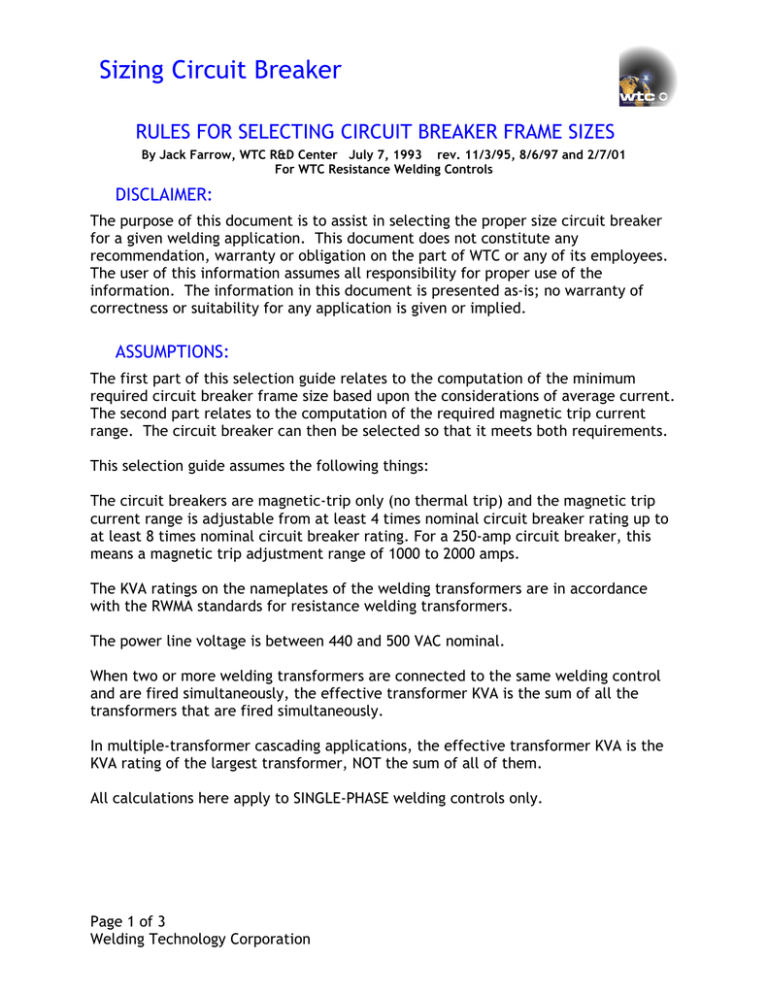Sizing Circuit Breaker - Welding Technology
advertisement

Sizing Circuit Breaker RULES FOR SELECTING CIRCUIT BREAKER FRAME SIZES By Jack Farrow, WTC R&D Center July 7, 1993 rev. 11/3/95, 8/6/97 and 2/7/01 For WTC Resistance Welding Controls DISCLAIMER: The purpose of this document is to assist in selecting the proper size circuit breaker for a given welding application. This document does not constitute any recommendation, warranty or obligation on the part of WTC or any of its employees. The user of this information assumes all responsibility for proper use of the information. The information in this document is presented as-is; no warranty of correctness or suitability for any application is given or implied. ASSUMPTIONS: The first part of this selection guide relates to the computation of the minimum required circuit breaker frame size based upon the considerations of average current. The second part relates to the computation of the required magnetic trip current range. The circuit breaker can then be selected so that it meets both requirements. This selection guide assumes the following things: The circuit breakers are magnetic-trip only (no thermal trip) and the magnetic trip current range is adjustable from at least 4 times nominal circuit breaker rating up to at least 8 times nominal circuit breaker rating. For a 250-amp circuit breaker, this means a magnetic trip adjustment range of 1000 to 2000 amps. The KVA ratings on the nameplates of the welding transformers are in accordance with the RWMA standards for resistance welding transformers. The power line voltage is between 440 and 500 VAC nominal. When two or more welding transformers are connected to the same welding control and are fired simultaneously, the effective transformer KVA is the sum of all the transformers that are fired simultaneously. In multiple-transformer cascading applications, the effective transformer KVA is the KVA rating of the largest transformer, NOT the sum of all of them. All calculations here apply to SINGLE-PHASE welding controls only. Page 1 of 3 Welding Technology Corporation Sizing Circuit Breaker PART 1: CIRCUIT BREAKER MINIMUM FRAME SIZE SELECTION GUIDE There are three classes of duty cycle to consider: A HIGH duty cycle application is seam welding. For HIGH DUTY CYCLE applications, the circuit breaker size should be: CIRCUIT BREAKER SIZE (amps) = TRANSFORMER NAMEPLATE KVA x 2 A MEDIUM duty cycle application is defined as 7 spot welds or more in any 30-second time interval. This corresponds to a duty cycle of more than 5%. Robot applications, manually operated welders, or multi-transformer cascading controls usually fall into this category. For MEDIUM DUTY CYCLE applications, the circuit breaker size should be: CIRCUIT BREAKER SIZE (amps) = TRANSFORMER NAMEPLATE KVA X 1.6 A LOW duty cycle application is defined as 6 or fewer spot-welds in any 30-second time interval. This corresponds to a duty cycle of 5% or less. Welders on fixtures or hard automation usually fall into this category. For LOW DUTY CYCLE applications, the circuit breaker size should be: CIRCUIT BREAKER SIZE (amps) = TRANSFORMER NAMEPLATE KVA X 1.3 The result of the calculation of PART 1 sets the MINIMUM acceptable circuit breaker frame size, based on average current considerations. Depending upon the results of the computation for the required magnetic trip setting (PART 2), a larger circuit breaker may be required. Page 2 of 3 Welding Technology Corporation Sizing Circuit Breaker PART 2: MAGNETIC TRIP RANGE SELECTION. The selection of magnetic trip range is determined by maximum peak current draw, not duty cycle or average current. In order to compute maximum peak current draw, maximum welding current, type of welding machine, and number of welds made simultaneously need to be known. The following generalizations are biased toward worst-case; they will usually indicate a need for a higher magnetic trip range than what is actually needed. These generalizations should be used ONLY if better data is not available. The basic formula for selecting the required magnetic trip setting is: MTS = WC * NSW * MF Where: MTS = Magnetic trip setting WC = Welding current per weld; assume 18,000 amps for steel, and 40,000 amps for aluminum NSW = Number of simultaneous weld loops. Usually, this is equal to the number of weld spots. Where series welding is used, each pair of weld spots counts as one. MF = Machine factor; 0.084 for a hanging gun station, 0.042 for a machine or fixture welder, 0.021 for an integral transformer welding gun. EXAMPLE: Assume that four welds on a steel automobile body are made simultaneously in a fixture-type welding machine. Using these assumptions: WC = 18,000 amps (for steel) NSW = 4 (4 welds made simultaneously) MF = 0.042 (for a fixture welder) The required magnetic trip setting would be: MTS = 18,000 * 4 * 0.042 = 3042 amps If the required magnetic trip setting is higher than what is available on a circuit breaker frame size selected according to the first part of this write-up, a larger circuit breaker is required. The circuit breaker size should be selected according to EITHER average current or peak current considerations, whichever is higher. Page 3 of 3 Welding Technology Corporation

